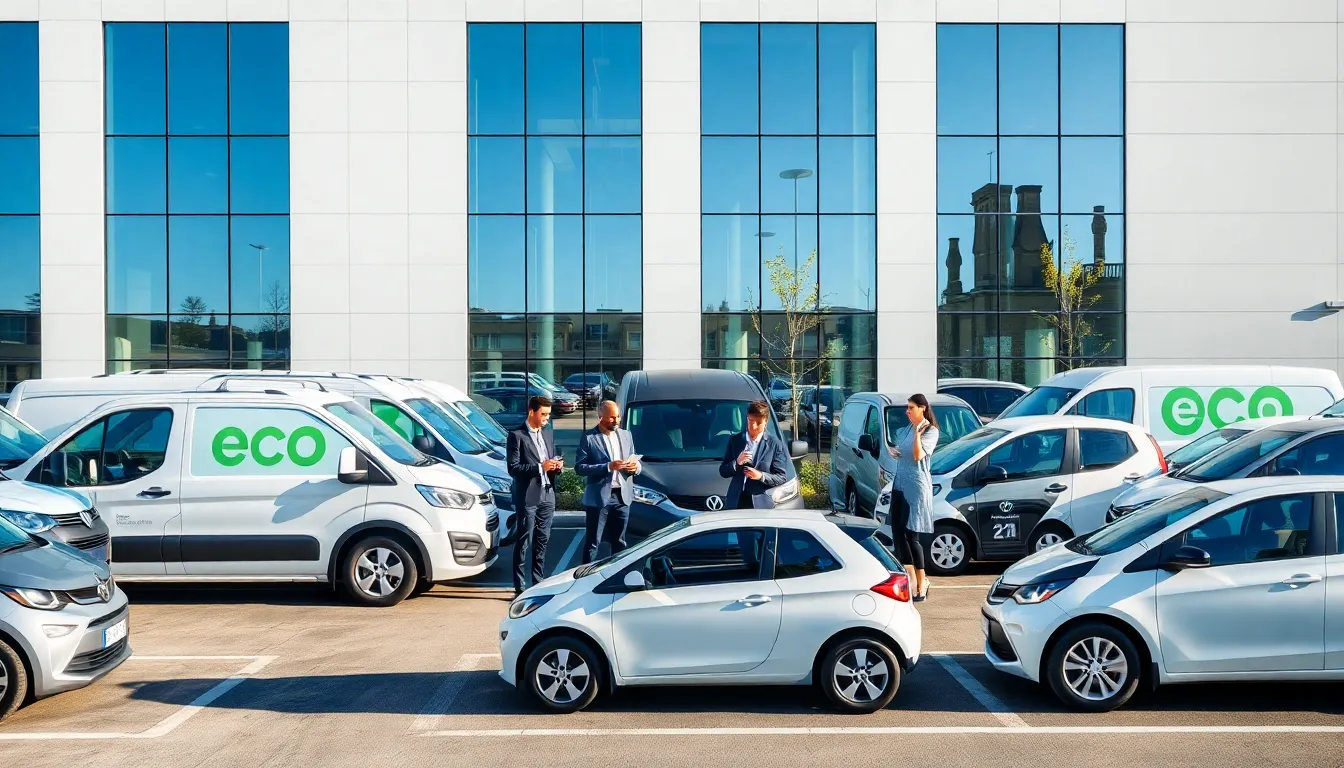Think you can’t run a fleet without loud engines and gas guzzlers? Think again. Welcome to the dawn of the electric vehicle fleet, where whisper-quiet rides meet the robust demands of efficient transportation. With more companies ditching the fossil-fueled dinosaurs for sleek, battery-powered cars, the future of transportation looks cleaner, greener, and rather exciting. So, buckle up as we explore the ins and outs of electric vehicle fleets, because this ride is just getting started.
Table of Contents
ToggleUnderstanding Electric Vehicles: An Overview

Electric vehicles (EVs) are automobiles powered by one or more electric motors, using energy typically stored in rechargeable batteries. Unlike traditional vehicles relying on internal combustion engines, EVs eliminate emissions during operation, making them an eco-friendlier option. The market has evolved dramatically over the years, with major advancements in technology improving battery life, range, and overall vehicle performance.
In essence, an electric vehicle fleet comprises multiple EVs operated by a single organization, intended for various transportation needs. From delivery vans to passenger cars, these fleets are being embraced across multiple industries. With the recognition of climate change and the push towards sustainable practices, the shift to EVs is not just a trend, it’s becoming a necessity.
Benefits of Electric Vehicle Fleets
The benefits of integrating electric vehicles into a fleet are compelling. Here are some key advantages that make EVs an ideal choice:
- Cost Savings: EVs often have lower fuel costs compared to their gasoline counterparts. According to the U.S. Department of Energy, electric vehicles can save fleet owners up to 50% on fuel expenses over time.
- Reduced Maintenance: With fewer moving parts and no oil changes needed, EVs typically require less maintenance, translating into reduced upkeep costs.
- Environmental Impact: Electric vehicles contribute significantly to reducing greenhouse gas emissions, helping organizations meet sustainability goals and appeal to eco-conscious consumers.
- Performance and Reliability: Many electric vehicles offer superior acceleration and handling due to the instant torque provided by electric motors. They tend to have enhanced reliability, thanks to fewer mechanical issues.
- Regulatory Incentives: Many governments offer tax credits, rebates, and grants for transitioning to electric vehicles, further reducing the initial investment.
By capitalizing on these benefits, businesses can position themselves not just as financially savvy but also as champions of sustainability.
Challenges in Implementing Electric Vehicle Fleets
While the benefits are clear, transitioning to electric vehicle fleets doesn’t come without its share of challenges:
- Initial Investment: The upfront cost of electric vehicles can be higher compared to traditional vehicles. Although operating costs may decrease over time, the initial expenditure can be a significant barrier.
- Charging Infrastructure: The availability of charging stations remains a concern. Depending on location, fleets may face challenges in finding adequate charging solutions to support daily operations.
- Range Anxiety: Although newer models now boast impressive ranges, fleet operators still worry about battery life and distances between charging stations, especially for long-haul routes.
- Employee Training: Transitioning from traditional vehicles to EVs may require training staff on new technologies and even driving styles, which can lengthen the adaptation period.
- Government Policies: Changing regulations can impact the viability of electric fleets, with fluctuating incentives and rebates causing uncertainty in long-term planning.
Awareness of these challenges is vital for organizations considering a shift to electric vehicles.
Strategies for Successful Electric Vehicle Fleet Management
Successfully managing an electric vehicle fleet is an ongoing process that involves strategic planning. Here are useful strategies to consider:
- Conducting a Needs Assessment: Evaluate the specific needs of your fleet, consider the types of vehicles required, distance traveled, and typical load. A well-informed assessment can significantly lower costs and maximize efficiency.
- Investing in Charging Infrastructure: Setting up dedicated charging stations can greatly enhance fleet efficiency. Assessing locations based on fleet operations can help strategic placements and ensure easy access.
- Using Fleet Management Software: Carry out advanced fleet management tools to monitor vehicle performance, track charging status, and optimize routes. This tech can provide real-time data, eventually improving efficiency and cost management.
- Developing Policies for Drivers: Creating comprehensive guidelines for using electric vehicles can ensure consistency in operation and set clear expectations on charging and maintenance practices.
- Regular Training and Education: Continuously educating and training employees on the idiosyncrasies of electric vehicles will help better understanding and operational efficiency. Familiarity breeds efficiency, after all.
The Role of Infrastructure in Electric Vehicle Adoption
Infrastructure plays a crucial role in the widespread adoption of electric vehicles. The development of an extensive network of charging stations is essential for providing convenience to fleet operators and drivers. Without sufficient charging points, the transition to electric vehicles could be hampered by range anxiety. Cities and private companies are increasingly investing in:
- Fast-Charging Stations: Rapid charging solutions drastically reduce downtime, allowing fleets to remain operational longer without extended stops for charging.
- Home Charging Solutions: For companies with stable base operations, installing charging points at depots can streamline vehicle management and help day-to-day operations.
- Public-Private Partnerships: Collaborations between government and private sectors can fast-track infrastructure development, ensuring that charging solutions are widely available and accessible.
- Smart Charging Solutions: Utilizing technology that allows for charging during off-peak hours can alleviate demand on the grid and reduce costs. Advanced solutions can dynamically adjust charging based on grid demands.
With a robust infrastructure in place, electric vehicle adoption can progress smoothly, leading to a greener transportation network.
Future Trends: The Evolution of Electric Vehicle Fleets
The future of electric vehicle fleets appears vibrant and full of innovations. Here are a few trends to keep an eye on:
- Autonomous Electric Vehicles: The rise of autonomous driving technology could dovetail nicely with electric fleets, combining efficiency with reduced labor costs.
- Battery Technology Advancements: Improvements in battery technology promise both longer ranges and faster charging times, addressing concerns surrounding current technology constraints.
- Shared Mobility Services: With trends leaning toward shared transportation, electric vehicle fleets could become integral to services like ride-sharing and car-sharing programs.
- Integration with Renewable Energy: As renewable energy sources expand, pairing fleets with solar or wind energy can enhance sustainability, ensuring minimal environmental impact.
- Regulatory Support: Ongoing support from governments in the form of incentives will likely bolster further adoption, encouraging fleets to shift to greener alternatives.
These trends will shape the future of electric vehicles, influencing how organizations conduct their operations.



